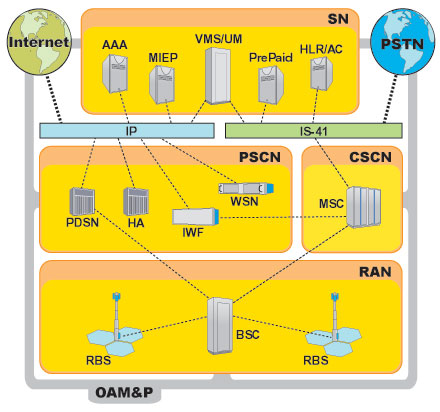CDMA2000 1xEV
The evolution of CDMA2000 beyond 1X is now labeled CDMA2000 1xEV. 1xEV will be divided into two steps: 1xEV-DO and 1xEV-DV. 1xEV-DO stands for 1X Evolution Data Only. 1xEV-DV stands for 1X Evolution Data and Voice. Both 1xEV evolution steps provide for advanced services in CDMA2000 using a standard 1.25 MHz carrier.
Evolution with CDMA2000 will therefore continue to be backwards-compatible with today's networks and forwards-compatible with each evolution option. 1xEV-DO will provide for higher data rates on 1X systems. 1xEV-DO will require a separate carrier for data, but this carrier will be able to handoff to a 1X carrier if simultaneous voice and data services are needed. By allocating a separate carrier for data, operators will be able to deliver peak rates in excess of 2 Mbps (best effort) to their data customers. 1xEV-DV solutions will be available approximately one and a half to two years after 1xEV-DO. 1xEV-DV will bring data and voice services for CDMA2000 back into one carrier. A 1xEV-DV carrier will provide not only high-speed data and voice simultaneously, but will also be capable of delivering real-time packet services.
CDMA2000 Packet Core Network
The standards for a CDMA Packet Core Network (PCN) were developed as part of the Third Generation Partnership Project 2 (3GPP2) working groups. These standards were developed by using existing standards from the IETF (Internet Engineering Task Force) on Mobile IP. 3GPP2 is also busy defining the evolution of a CDMA2000 network to All-IP. The CDMA2000 PCN is the first step in this evolution.
To provide secure and efficient transport for wireless data, Ericsson has introduced a data delivery mechanism using the PCN. The PCN network is comprised of the Packet Data Serving Node (PDSN) and the Authentication, Authorization and Accounting server (AAA). The Home Agent (HA) can be added to provide Mobile IP-based packet data services.
For more information about Ericsson CDMA2000 products
Product and Service Solutions that Deliver the Full Advantage of CDMA Technology
Leveraging proven leadership in mobile networks and packet switching, the CDMA2000 product portfolio is built on Ericsson's 3G global platform technology. By combining industry-leading compact radio access and circuit-switched core network products with the flexible and advanced packet-switching capabilities of the CDMA2000 Packet Core Network, Ericsson assures operators of a cost-effective, future-proof solution to meet today's wireless needs and tomorrow's emerging markets.

Radio Access Network
Ericsson's CDMA2000 1X Radio Access Network (RAN) provides a comprehensive solution for mobile network operators, offering state-of-the-art Radio Base Stations (RBS) and Base Station Controllers (BSC), operational efficiencies and a smooth evolution to next-generation technologies
Packet-Switched Core Network
By combining a Wireless LAN Serving Node (WSN) to the flexible and advanced packet-switching capabilities of the CDMA2000 Packet Core Network (PCN) - comprised of the PDSN and HA nodes - Ericsson assures operators of always best-connected functionality and direct access to IP-service networks.
Circuit-Switched Core Network
Designed to provide switching and gateway functionality for voice users, the Circuit-Switched Core Network (CSCN) consists of the AXE 10 and the AXE 810 MSC.
Service Network
The Service Network consists of service enablers such as the Home Location Register, the Authentication Center, the Authentication, Authorization and Accounting server, the Mobile Internet Enabling Proxy and service applications such as PrePaid Calling, Messaging Over IP and Enhanced Voice Mail.
|